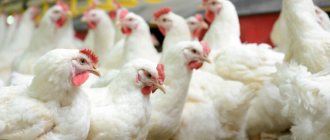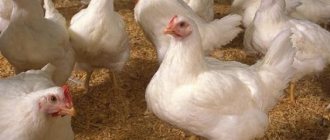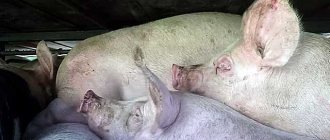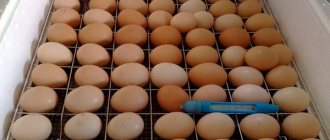Beginning poultry farmers are wondering what is better: raising broilers in cages or in a special pen. To make an informed decision, you need to have complete information about the correct keeping of chickens. Broilers are bred for weight gain in a short time, so it is important to create favorable conditions for the chickens so that they develop properly.
Advantages and disadvantages of cellular content
Pros:
- saving space - placing more heads in the same area;
- reduction in fattening time , which leads to an increase in farm profits;
- increased live weight gain and more production per unit area compared to other methods of raising broilers;
- due to the physical restriction of the poultry’s physical activity, the consumption of feed by broilers is reduced , which, accordingly, reduces the total consumption of feed mixtures;
- due to the lack of bedding, the question of its constant replacement is eliminated;
- reduction of energy costs for heating, lighting and ventilation;
- there is a tray for collecting litter , which is often cleaned;
- presence of a feeder and automatic drinker;
- limiting contact between birds and each other , which leads to a reduction in the risk of epizootic and invasive diseases;
- less need for maintenance personnel , which means reduced costs.
Minuses:
- cage equipment is more expensive than floor equipment;
- complexity and labor intensity of disinfection and cleaning of cage equipment;
- lower quality level of veterinary care , labor intensity of vaccination;
- increased risk of infectious epidemics due to overcrowding of chickens;
- higher percentage of mortality and culling of birds;
- presence of skin deposits on the breast bone of broilers;
- Leg problems in overweight birds due to mesh flooring;
- the difficulty of ensuring uniform lighting , heating and high-quality ventilation;
- difficulty achieving uniformity of livestock weight;
- decreased taste of meat and eggs.
How to properly organize a broiler business?
Read
Chickens for slaughter - when can birds be used for meat?
More details
Broilers are meat chickens that are genetically engineered for rapid weight gain.
Look
The best breeds and crosses of Russian chickens: top 5 most productive chickens
Further
Heating
The heating problem will definitely have to be solved by those farmers who live in the northern regions, because even the thickest and most insulated walls will not save broilers from frost. Today there are several effective ways to solve the heating problem:
- large infrared lamps;
- bake;
- electric heater.
One of the heating methods is infrared lamps
We present a comparative table of all the pros and cons of these heating elements.
| Infrared lamps | Bake | Electric heater | |
| Advantages |
|
|
|
| Flaws |
|
|
Many farmers prefer infrared equipment, since it is the least hassle. There is no need to place lamps inside broiler cages; they are hung at the top, not under the ceiling itself, but slightly lower. Several large infrared lamps are sufficient to heat a standard-sized shed. They are not expensive and consume little electricity. Of course, in the event of prolonged power outages, it is necessary to stock up on additional heating equipment, but usually the supply of electricity is quickly restored.
You can install a potbelly stove in a room with broiler cages
As for the stove, this is the second most popular method of supplying heat to broiler cages, since birds are usually placed in permanent outbuildings to the house. Fuel for stoves in Russia is not expensive; it is usually used to heat human homes in villages. A lot of heat comes from the stove, which makes the birds comfortable. However, in order to use the stove, you need to constantly add new portions of coal or firewood to it and it must always be on the site, next to the poultry house. Usually they live in villages permanently and do not travel with the whole family, since the farm, in addition to broilers, also includes other birds or animals.
Remember, operating the stove is a fire hazard.
As for electric heaters, they have only one problem - the high cost of both the device and the electricity. Sometimes one device may not be enough to heat the entire room where the broiler cages are installed, and then you will have to purchase several more. This excessive use of electricity will result in huge utility bills and will eventually force you to abandon the electric heating element, despite its obvious advantages.
Heating a broiler cage with an infrared lamp
However, those who live in regions with mild and short winters, without frost and heavy rainfall, should still pay attention to electric heaters. If broilers will be kept in tiered or aviary cages in a small room, use an electric heater
You will only need it for a short time, during the coldest period, so you will not incur significant financial losses.
Conditions for growing broilers in cages
The health and productivity of broilers depend on the proper organization of space with cages and their equipment, as well as compliance with zootechnical standards and a favorable microclimate.
Cell requirements
The preferred material of manufacture is galvanized steel rod with a diameter of 2 mm, for the floor - at least 3 mm. Some manufacturers produce cages with plastic floors, which helps reduce bird injuries. The optimal cage depth is 30 cm, height – 25 cm. The width depends on the number of chickens housed:
- up to 50 cm – 3-4 broilers;
- up to 70 cm – 6-8 broilers;
- up to 120 cm – 10-12 broilers.
The cell can be a single block or a system of cells combined in height and width. In large farms they are placed in batteries - 2-3 tiers in height.
Block cells are often divided in the center by a partition into 2 cells. Cells are placed with free access to them.
Cell equipment
Broiler cages are equipped with the following equipment:
- trays for collecting and removing litter;
- heating and lighting devices;
- thermometers for measuring temperature in cells;
- feeding and watering systems;
- ventilation.
The front wall of the cages may have a sliding door, closed with a latch, for disembarking broilers. If there are several tiers, wheels are installed for easy movement of the blocks.
Useful tips
To ensure that broilers feel good and gain weight quickly, experienced poultry farmers give the following recommendations:
- Conduct farm inspections several times a day, identifying possible problems and rejecting low-quality livestock.
- Use automation to control heating, ventilation and lighting of the poultry house.
- Feed only high-quality food from trusted manufacturers, and not from “bucket” sellers from the market.
- If possible, do not combine broilers and laying hens in adjacent cages - they have different feeding regimes and different functions from each other.
- Litter can be removed either manually or a conveyor system can be installed to collect excrement for further use as fertilizer.
Breeding broilers is quite an interesting activity for farmers, both beginners and experienced.
Did you know? The word broiler comes from the English to broil, which means to fry on a spit.
These unpretentious birds are very responsive to care, and raising them is a quickly profitable business.
Microclimate and zootechnical standards
Important elements of the microclimate when raising broilers in cages are temperature, humidity, ventilation and compliance with the light regime.
Temperature and humidity
In a chicken coop with cages, it is necessary to maintain a constant temperature, which is controlled using thermostats that automatically maintain the thermal level.
For local heating use:
- infrared lamps;
- electric heaters;
- ultraviolet irradiators;
- gas heaters (require a license, so are more suitable for farms).
The temperature depends on the age of the broilers:
- 33-35° – for chickens from 1 to 7 days;
- 26-29° – 8-21 days;
- 20-22° – from 3 weeks of life.
Expert opinion
Sadchikov Nikolay Alekseevich
Veterinarian ornithologist
Ask a Question
The relative humidity level in the room should be 60-70%. The state of the birds' respiratory system and the perceived temperature depend on it.
With a high level of humidity during the hot season, the temperature is felt higher than the existing one. At low humidity, broilers lose more fluid.
Broiler cage rating: TOP 9 models
Read
The influence of temperature on broiler chickens
More details
Daily weight of broilers from birth to 60 days of life
Look
Ventilation
Boilers that are 21 days or older generate a lot of heat, which produces ammonia and carbon dioxide fumes, which can cause various diseases and lead to reduced feed intake and weight gain. Therefore, if there are a large number of broilers in the chicken coop cages, a forced ventilation system (air supply and removal) is needed to provide fresh air year-round, which also helps reduce high air temperatures in the summer. The organization of forced ventilation is calculated per kilogram of live weight of the bird per hour and amounts to 1.5-2.0 m3 in winter, 4.8-9.6 m3 in summer. The outside air temperature is taken into account.
Light mode
The duration of daylight for broilers is 15-18 hours, and for chickens in the first two weeks of life - around the clock. From the third week until slaughter, alternating periods (intermittent lighting) are practiced: 1 hour of light, 2 hours of darkness.
According to the standards, for 4 sq. m of poultry house requires 100 or more watts of lighting from incandescent lamps or 12 watts of LED lighting.
The light regime for broilers is aimed at stimulating feed consumption.
Selection rules
Raising broilers begins with choosing eggs or purchasing chickens. The final result depends on the correct actions on your part. Let's dwell on the selection rules.
Eggs for incubation
Fertilized eggs are selected and must meet the following criteria:
- free from external defects and contamination;
- be approximately the same size;
- they were laid by healthy chickens within a week before being placed in the incubator.
If you examine an egg through an ovoscope, then a uniform air chamber should be located at the blunt end of the egg. Before storing, they are stored at a temperature not lower than +10°C. Immediately before laying, the eggs are warmed to room temperature to avoid the formation of condensation on the surface when placed in the incubator.
Read more about how to hatch chickens in an incubator at home.
Chickens
When purchasing chickens at the market, consider the following:
- a healthy chicken is always mobile and active;
- the fluff is smooth, soft, free of dirt and blood;
- eyes are shiny, without films or discharge;
- legs are straight;
- the body is proportional, without curvature.
Depending on the breed, chickens can be of different shades: yellow, brown, striped. In autosex breeds, color is a sign of gender. Therefore, when buying chickens of a specific breed, you need to know exactly how to distinguish a chicken of the chosen breed from others.
For breeds where males and females are the same color, there is no way to accurately determine sex. At the time of sale, broiler chickens are 1–4 weeks old.
- Buying chicks has undeniable advantages:
- no need to waste time and resources on incubation;
- you will immediately receive as many chickens as you need;
- You can immediately buy older chickens and avoid difficulties in raising them.
But you cannot be sure of the quality of the purchased chickens: whether they have been vaccinated, whether they have been overcooled and other factors.
Feeding and watering front
Zootechnical standards for cage rearing of broilers include:
- Feeding front : with a groove system it is 2-2.5 cm per 1 head; using a round feeder involves feeding 40-70 birds.
- Drinking front : for 1 nipple – 10-12 heads. When using a vacuum drinker - 1 piece for 50 chickens. The groove design is designed with access of 2 cm per head.
Feeders for the chicken coop. Top 15 best positions
Read
Rating of drinking bowls for chickens. Top – 15 best positions
More details
Rating of electric heaters and heating options without electricity
Look
Breeding Cobb hybrid chickens 500
Special technology
Obtaining hatching eggs of the Cobb 500 hybrid is possible only using special technology developed in the Czech Republic and Poland.
Reasons why it is impossible to breed this type of chicken in the traditional way: Cobb 500 does not inherit the qualities obtained from mixed breeds.
Cobb 500 eggs and young animals are imported to Russia for sale to small and large farms. The cost of day-old chicks on the market is 100 rubles. Per head. The price of hatching eggs is much lower - up to 40 rubles per egg.
Considering that young animals have a high viability of up to 97%, it is more profitable to purchase hatching eggs.
Incubation mode of hybrid Cobb 500 by day
Eggs are laid in the incubator horizontally or vertically with the sharp end down. The incubation process lasts 21 days.
The temperature in the incubator is maintained within 37-38 degrees. Humidity on days 1-10 is 30%, on days 11-21 it gradually increases to 70%.
Eggs must be turned and cooled according to schedule.
For the first 2-3 days, the chicks are fed with chopped boiled eggs, cottage cheese, crushed millet, and mash with milk. After 3 days, chopped dandelion grass and thistle are added to the food. Next, according to the scheme, pre-start - starting - finishing feed.
Early Cobb 500 broiler chicks must be vaccinated against infectious diseases.
Instructions for building a cage, how to do it yourself
Now it’s worth moving on to the most important point - making cages with your own hands in which the birds will feel comfortable and cozy.
Drawings of successful options
Having studied a variety of designs and selected a suitable cage design, the home craftsman can begin to work - building a cage is much easier than it seems at first glance.
For work you will need the following materials:
- wooden beam with a cross section of about 50×50 mm,
- timber with a cross section of about 20×20 mm,
- plywood,
- sheets of metal - preferably galvanized,
- mesh with a cell of about 20×20 mm,
- self-tapping screws
You only need the simplest tools - a screwdriver, a hacksaw, a hammer, a meter and a marking pencil. If it is possible to replace the first three with a screwdriver, an electric jigsaw and a construction stapler, then it will be even easier to build cages that will last for years.
Important! When assembling, you need to make sure that there are no sharp surfaces in the cage that could injure the birds.
All work consists of several stages:
- Four pieces 100 cm long and eight 60 cm long are cut from the timber.
- The frame of the future cage is assembled from timber - a parallelepiped 100 cm long, 60 cm deep and 40 cm high. For fastening it is better to use thin and long self-tapping screws. Moreover, when assembling the bottom, the transverse beam is not attached to the corners, but about 20 cm higher.
- A piece of plywood of a suitable size is attached to the top.
- The front, side and rear walls are covered with mesh - the bottom should have a cell of 20x20 mm, and the rest can be larger - this will save on materials. You can secure the mesh with small nails or staples from a stapler.
- A hole is cut in the front of the mesh, where the door is later installed - it can also be made from a metal mesh, secured to a wire.
- A thin beam is attached to the lower corners - two are enough, on the left and on the right.
- A pallet of a suitable size is assembled from sheets of metal, which is installed on thin beams.
This concludes the production - the cell is ready.
Rules of care
Unlike free-range chickens, caged birds do not have the opportunity to move to a cooler or brighter area. Creating the most comfortable conditions for chickens depends entirely on the farmer. Purchase temperature and humidity sensors and carefully monitor their readings and the microclimate in the room.
Effect of stocking density on broiler performance and health
Effect of stocking density
The correct stocking density of broilers when kept on floors allows for efficient use of farm space and technological equipment.
Correct calculation of the stocking rate for broilers when kept on floors has a positive effect on:
- poultry health;
- its productivity;
- cultivation costs;
- quality of the final product;
- cost and final profit.
An incorrect indicator of the norm for floor housing of broilers leads to:
- increase in morbidity;
- increase in mortality;
- low productivity;
- poultry leg diseases;
- high levels of stress;
- poor quality of litter;
- decrease in factory profitability.
Is it possible to keep chickens outside?
In warm weather and in good weather, it is quite acceptable to keep cages with chickens outside. To make it easier to transport batteries, the cages can be equipped with wheels on the bottom.
Fresh air and natural light will have the most beneficial effect on productivity. It also prevents rickets in chickens, but they can only be taken outside from 2 weeks of age. Make sure that the birds do not overheat or, on the contrary, freeze.
So, to successfully keep broilers in cages you need:
- maintaining a favorable microclimate in the room where birds are kept;
- compliance with zootechnical standards;
- compliance with acceptable sanitary and hygienic conditions.
Follow these rules and your products will definitely take pride of place on the shelves among environmentally friendly products!
How to place birds inside cages, maximum density
Of course, in order for the birds to feel comfortable enough, and therefore to actively feed and grow quickly, certain rules must be followed. One of them is the correct population density.
Attention! According to zootechnical standards, there should be no more than 20-25 heads per square meter of cage.
Moreover, at the moment of reaching maximum growth, there is a maximum of 40 kilograms of live weight per square meter - otherwise the risk of illness and injury increases sharply.
conclusions
To summarize, we can say that cage-based rearing of broilers is beneficial both in industrial poultry farming and in private farming. The farmer determines the degree of mechanization of production based on the amount of labor, the total number of poultry raised for meat, and year-round production.
When growing in the summer for your own needs (50-100 birds), you can get by with 2-4 simple homemade cages. And if you plan to produce meat for sale (1000 heads of simultaneous planting or more) and make a serious profit, then select factory-produced designs with a nipple water supply system, mechanized feed distribution and manure removal.
Sources:
https://studopedia.su/14_84620_virashchivanie-broylerov-v-kletochnih-batareyah.html https://fermhelp.ru/kletochnoe-soderzhanie-brojlerov/ https://webferma.com/pticevodstvo/soderzhanie/broiler-v-kletke .html











